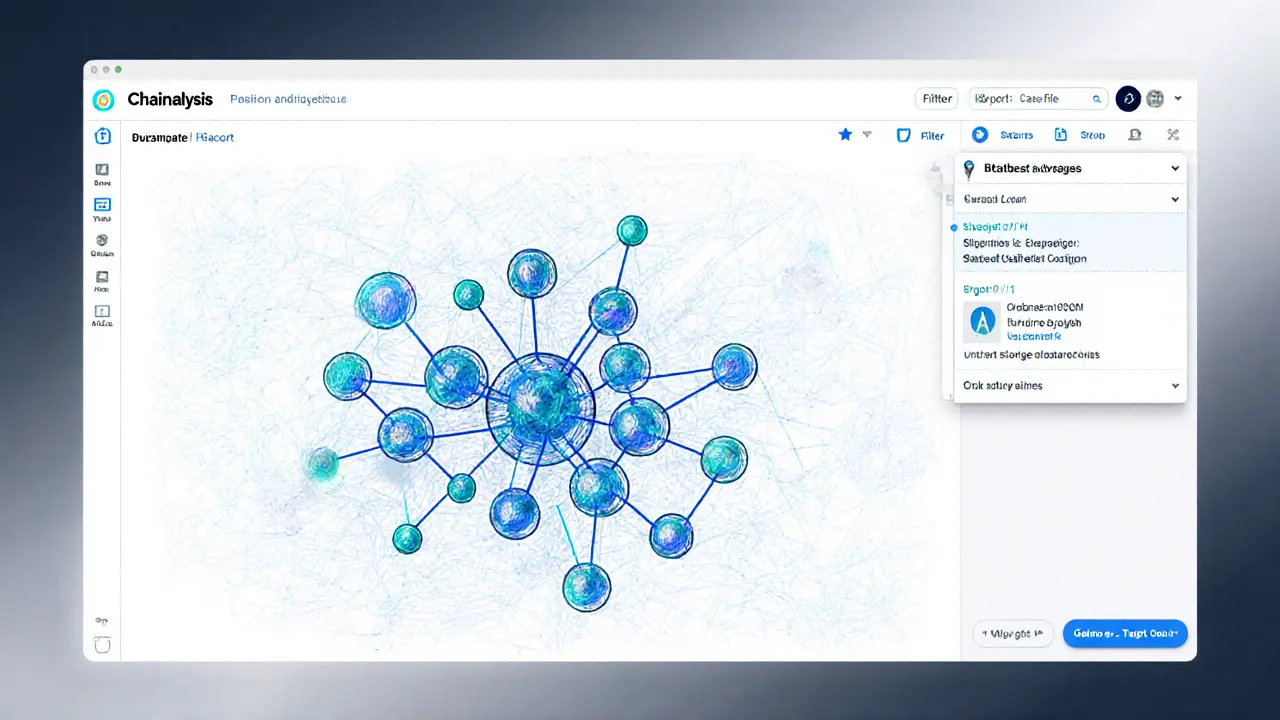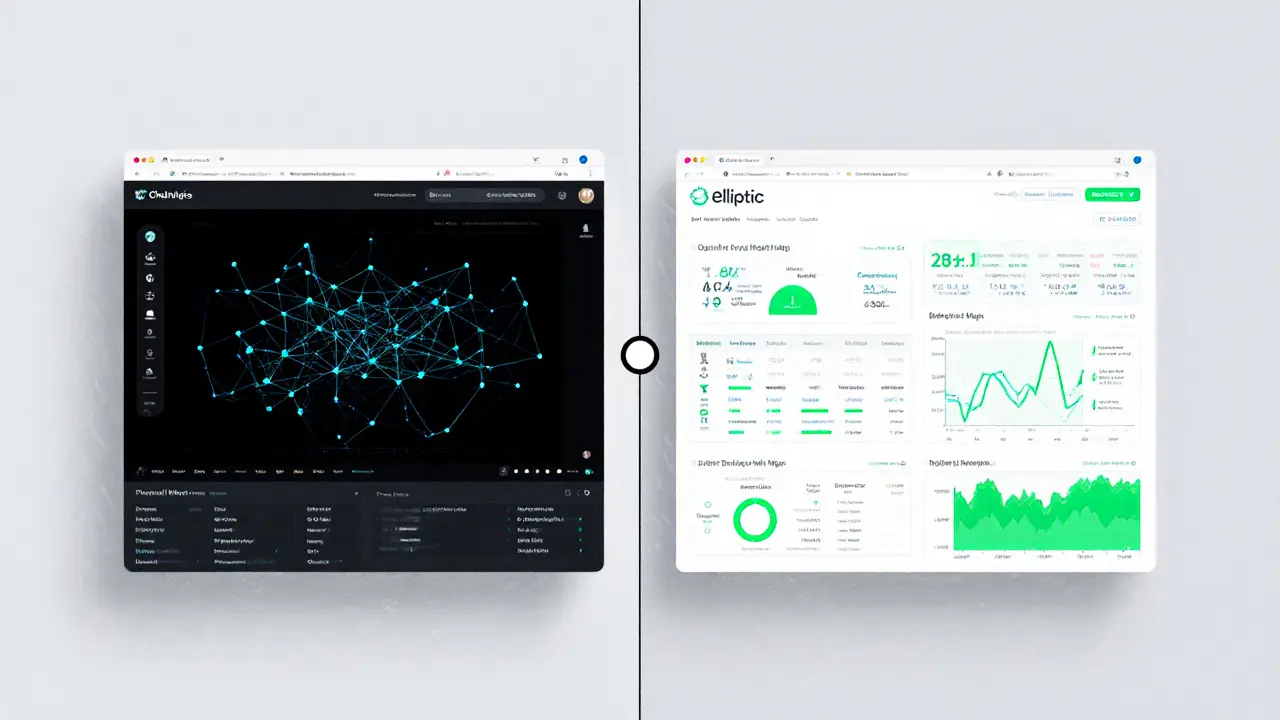Blockchain Forensics Tool Comparison
Tool Overview
Use this interactive to compare Chainalysis and Elliptic blockchain forensics tools based on your organization's needs.
Recommended Tool
Detailed Comparison
| Feature | Chainalysis | Elliptic |
|---|---|---|
| Primary Products | Reactor (investigation), KYT (real-time monitoring) | AML API, Predictive Risk Engine, Training Programs |
| Asset Coverage | ~85% of market value (focus on BTC, ETH, major tokens) | 100+ assets, 97% of market cap (incl. privacy coins) |
| Visualization | Advanced graph UI, clustering, case export | Dashboard with risk scores, limited graphing |
| Pre-block Monitoring | No (monitoring after transaction) | Yes (mempool analysis) |
| Predictive Analytics | Basic risk scoring, no forward-looking model | Machine-learning predictions of future risk |
| Government Adoption | High - Europol, US Treasury, major law-enforcement agencies | Growing - UK FCA, several European regulators |
| Training & Certification | Online courses, limited onsite | Extensive onsite workshops and certification tracks |
| Pricing Model | Enterprise tiered subscription, usage-based for KYT | Subscription with API call tiers, custom enterprise quotes |
When a suspicious crypto transaction shows up on a compliance dashboard, the real question is: how quickly can you see where the money went and who’s behind it? That’s where blockchain forensics tools step in. Two names dominate the space - Chainalysis is a leading blockchain analytics platform that provides investigative and real‑time monitoring solutions for law enforcement, regulators, and financial institutions and Elliptic is a comprehensive crypto AML provider that focuses on risk scoring, predictive analytics, and broad asset coverage for crypto‑focused businesses. Both were founded in 2013, but they’ve taken different paths to help trace crypto flows, flag illicit activity, and keep the ecosystem legit.
Key Takeaways
- Chainalysis excels at large‑scale investigations and visual network analysis through its Reactor product.
- Elliptic offers broader asset coverage (100+ assets) and predictive risk tools, especially for privacy‑focused coins.
- Both platforms require solid onboarding, API integration, and ongoing rule‑tuning.
- Regulatory pressure from EU MiCA and US Treasury guidance is driving faster adoption of these tools.
- Choosing the right tool depends on your organization’s asset mix, investigation depth, and compliance workflow.
What is Blockchain Forensics?
At its core, blockchain forensics is the practice of analyzing public ledger data to identify transaction patterns, cluster wallet addresses, and attribute activity to real‑world entities. Unlike traditional banking data, blockchain transactions are immutable and transparent, but that very transparency can be obscured by mixers, privacy coins, and complex DeFi protocols. Forensic tools apply machine‑learning clustering, heuristic rules, and massive proprietary databases to cut through the noise.
Chainalysis: Reactor and KYT
Chainalysis Reactor is an investigative suite that lets analysts build visual graphs of transaction flows, tag entities, and export case files for courtroom use. The interface feels like a map of a city: each address is a node, each transaction a street, and the colors show risk levels. Users can drag‑and‑drop to isolate a particular wallet, apply pre‑built clustering algorithms, and see how funds hop across exchanges, mixers, and DeFi contracts.
On the monitoring side, Chainalysis KYT is a real‑time transaction screening engine that assigns risk scores based on counter‑party history, transaction size, and exposure to known illicit clusters. KYT plugs into a crypto exchange’s onboarding flow or a financial institution’s AML system via API, flagging high‑risk transfers before they settle.
Key stats:
- Coverage of ~85% of total cryptocurrency market value.
- Monitors >1,800 services, including exchanges, wallets, and DeFi platforms.
- Helped law enforcement seize over $1billion from Silk Road‑related addresses.
Elliptic: AML API and Predictive Tools
Elliptic AML API is an automated risk‑scoring service that evaluates transactions in real time, offering customizable rule sets that match an organization’s risk appetite. What sets it apart is the ability to assess a transaction **before** it hits the blockchain via mempool monitoring, giving firms a chance to block suspicious activity early.
Elliptic also boasts the industry’s first predictive analytics module. By feeding historical illicit patterns into a machine‑learning model, the system can flag addresses that are likely to become high‑risk, even if they haven’t yet shown bad behavior.
Coverage highlights:
- Tracks >100 digital assets, covering 97% of all crypto market cap.
- Maintains a database of 10billion on‑chain data points.
- Specialized support for privacy coins like ZEC and ZEN, plus extensive mixers and DEX monitoring.
Side‑by‑Side Comparison
| Feature | Chainalysis | Elliptic |
|---|---|---|
| Primary Products | Reactor (investigation), KYT (real‑time monitoring) | AML API, Predictive Risk Engine, Training Programs |
| Asset Coverage | ~85% of market value (focus on BTC, ETH, major tokens) | 100+ assets, 97% of market cap (incl. privacy coins) |
| Visualization | Advanced graph UI, clustering, case export | Dashboard with risk scores, limited graphing |
| Pre‑block Monitoring | No (monitoring after transaction) | Yes (mempool analysis) |
| Predictive Analytics | Basic risk scoring, no forward‑looking model | Machine‑learning predictions of future risk |
| Government Adoption | High - Europol, US Treasury, major law‑enforcement agencies | Growing - UK FCA, several European regulators |
| Training & Certification | Online courses, limited onsite | Extensive onsite workshops and certification tracks |
| Pricing Model | Enterprise tiered subscription, usage‑based for KYT | Subscription with API call tiers, custom enterprise quotes |

Real‑World Use Cases
Law enforcement investigations. Agencies like the FBI and Europol rely on Chainalysis Reactor to map out illicit networks. In the Silk Road case, investigators used Reactor’s clustering to follow the flow of bitcoins from buyer wallets to the final cash‑out address.
Crypto exchanges. An exchange onboarding new users can plug KYT or Elliptic’s AML API into its KYC workflow. If a user tries to deposit from a mixer‑tainted address, the system throws a red flag, allowing the compliance team to halt the transaction.
Financial institutions. Banks that offer crypto custody services use Elliptic’s predictive engine to anticipate risk before a client’s wallet interacts with high‑risk protocols, helping meet the new EU MiCA requirements.
DeFi platforms. Both tools are extending support for DeFi contracts. Chainalysis recently added cross‑chain analysis for bridges, while Elliptic is improving its DEX monitoring to catch rug pulls early.
Implementation: What to Expect
Getting a forensic platform up and running isn’t a plug‑and‑play moment. Here’s a typical rollout timeline:
- Scope definition. List the assets you need to monitor, the regulatory regimes you’re subject to, and the internal teams that will use the tool.
- Data integration. Connect the API (KYT or AML API) to your transaction processing pipeline. You’ll need a reliable data lake to store raw blockchain snapshots if you plan to run deep investigations.
- Rule configuration. Both platforms ship with default risk rules, but you’ll want to adjust thresholds, add custom watch‑lists, and map alerts to your case‑management system.
- Training. Expect a 2‑week intensive for basic functionality, then a 4‑6‑week deep‑dive for advanced graph analysis or predictive model tuning.
- Ongoing tuning. Cryptocurrencies evolve fast. New token standards, emerging mixers, and novel DeFi exploits mean you’ll need to refresh rules quarterly.
Typical technical requirements include a high‑throughput API gateway, secure key management for API tokens, and a scalable compute environment (AWS, GCP, or Azure) to handle peak transaction volumes.
Market Outlook and Competitive Landscape
The blockchain forensics market was valued at roughly $3.2billion in 2024 and is projected to grow over 15% annually through 2028. Chainalysis and Elliptic together command about 70% of the enterprise segment, thanks to deep government ties and broad asset coverage.
Emerging rivals like TRM Labs and CipherTrace are nibbling at niche markets-TRM focuses on crypto‑native compliance workflows, while CipherTrace leans heavily into high‑frequency trading surveillance. However, both newcomers lack the combined investigative depth of Reactor and the predictive foresight of Elliptic’s engine.
Regulatory drivers are the biggest catalyst. The EU’s MiCA regulation, slated for full enforcement in 2026, obliges crypto service providers to perform ongoing AML checks on every transaction. In the U.S., Treasury’s 2024 guidance on “crypto‑related financial crimes” pushes banks to adopt real‑time screening solutions. These rules make a robust forensic stack not just optional but mandatory.
Choosing the Right Tool for Your Organization
If your primary need is deep investigative work-think tracing funds from a dark‑web sell‑off to the final cash‑out-Chainalysis Reactor is hard to beat. Its visual graph and courtroom‑ready export features have been validated in high‑profile cases.
If you run a multi‑asset exchange, a crypto‑focused bank, or a DeFi protocol that deals with privacy coins, Elliptic’s broader coverage and pre‑block risk scoring may give you a better safety net.
Consider hybrid deployments too. Some firms run KYT for real‑time alerts and keep Reactor on standby for detailed forensic follow‑up. The key is to match the tool’s strengths with your risk profile and compliance workflow.
Next Steps and Common Pitfalls
Before you sign a contract, ask yourself these questions:
- Do I need real‑time monitoring, deep investigation, or both?
- What percentage of my portfolio is in privacy‑focused assets?
- How mature is my internal compliance team? Will they need extensive training?
- Do I have the data infrastructure to store large blockchain datasets?
Typical pitfalls include under‑estimating the learning curve, neglecting rule‑maintenance budgets, and overlooking the need for cross‑team communication-technical staff often speak in data‑pipeline terms while compliance staff focus on risk thresholds.
To avoid these, start with a pilot on a single asset, measure detection accuracy, and iterate your rule set before scaling to the full portfolio.
Frequently Asked Questions
What is the difference between Chainalysis Reactor and KYT?
Reactor is a forensic investigation suite that visualizes transaction graphs and helps build case files, while KYT is a real‑time screening engine that assigns risk scores to transactions as they happen.
Can Elliptic detect privacy‑coin transactions?
Yes. Elliptic maintains specialized heuristics for ZEC, ZEN, and other privacy coins, allowing it to flag suspicious activity even when the on‑chain data is obfuscated.
How do these tools integrate with existing AML systems?
Both platforms expose RESTful APIs. You can push alerts into your case‑management system, trigger automated sanctions checks, or feed risk scores into a SIEM for broader monitoring.
Is there a free trial available?
Both companies offer limited‑time pilots or sandbox environments, but full‑scale deployments require a negotiated enterprise contract.
Which tool is better for DeFi protocol monitoring?
Chainalysis has recently added cross‑chain bridge analytics, making it strong for tracing assets moving between L1 and L2. Elliptic, however, offers real‑time mempool monitoring that can block risky DeFi trades before they settle. The best choice depends on whether you prioritize post‑trade forensics or pre‑trade risk prevention.

